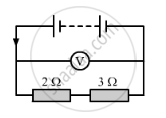Advertisements
Advertisements
Question
In the circuit shown below, the voltmeter reads 10 V.

(a) What is the combined resistance?
(b) What current flows?
(c) What is the p.d. across 2 Ω resistor?
(d) What is the p.d. across 3 Ω resistor?
Solution
(a) The resistors of 2 Ω and 3 Ω are connected in series.
Therefore their combined resistance, R = R1 + R2
Here, R1=2 Ω
R2=3 Ω
So, the combined resistance, R = 2 Ω + 3 Ω
R = 5 Ω
(b) The current, I in the circuit can be calculated as:
V = IR
or I = 10 / 5 = 2 At)=R2R1+R2v(t)
(c) The p.d. across the 2 Ω resistor is:
V = IR
or V = `2xx2` = 4 V
(d) The p.d. across the 3 Ω resistor:
V = IR
or V = 2 x 3
or V = 6 V
APPEARS IN
RELATED QUESTIONS
The p.d. across a 3 Ω resistor is 6 V. The current flowing in the resistor will be:
(a) `1/2A`
(b) 1 A
(c) 2 A
(d) 6 A
A car headlight bulb working on a 12 V car battery draws a current of 0.5 A. The resistance of the light bulb is:
(a) 0.5 Ω
(b) 6 Ω
(c) 12 Ω
(d) 24 Ω
60 joules of heat was dissipated in a resistor when 20 C flowed for 5 s. Calculate:
(a) P.d. across the resistor,
(b) Resistance of the resistor, and
(c) Average power dissipated in the resistor.
A bulb is connected to a battery of p.d. 4 V and internal resistance 2.5 Ω . A steady current of 0.5 A flows through the circuit. Calculate:
The energy dissipated in the bulb in 10 minutes.
An electrical gadget can give an electric shock to its user under certain circumstances. Mention any two of these circumstances.
Small amounts of electrical current are measured in milliampere (mA). How many milliampere are there in 0.25 A ?
The number of electrons constituting a 1-coulomb charge is ______.
Match the items in column-I to the items in column-II:
| Column - I | Column - II |
| (i) electric current | (a) volt |
| (ii) potential difference | (b) ohm meter |
| (iii) specific resistance | (c) watt |
| (iv) Electrical power | (d) joule |
| (v) electrical energy | (e) ampere |
